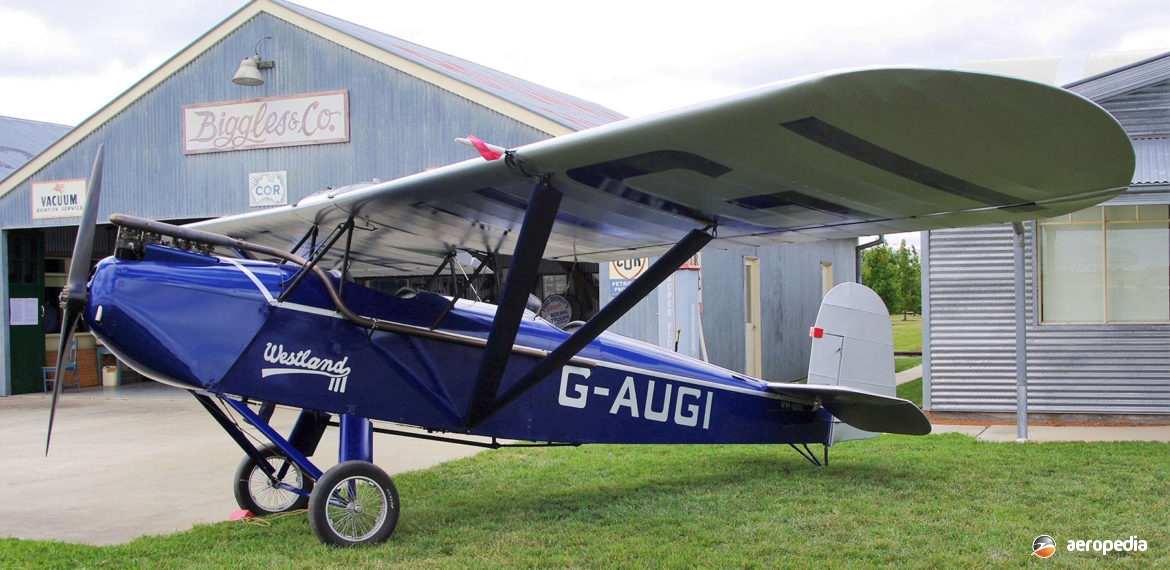Photograph:
Westland Widgeon G-AUGI (c/n WA1681) operated by Dick Smith from his airstrip at Bowylie, NSW in March 2011 (David C Eyre)
Country of origin:
United Kingdom
Description:
Two-seat light touring aircraft
Power Plant:
One 63 kw (85 hp) ADC Cirrus II four-cylinder in-line air-cooled engine
Specifications:
History:
The Westland Widgeon, a parasol-wing aircraft with fabric covering and a spruce girder fuselage, was built for the 1924 Lympne Trials in the United Kingdom. Designed with a folding wing for ease of storage, the prototype was first flown at Yeovil in Somerset on 22 September 1924, but five days later it crashed, necessitating reconstruction. Development continued for a few years, and models built included the Mks II, IIA, III and IIIA. The latter two had a plywood fuselage and constant chord mainplane, and a variety of engines was fitted to production aircraft.
At the time of building the Widgeon series, the manufacturer was also involved in production of the Westland Wapiti for the RAF and other air forces (including the RAAF). Production of the Widgeon ended in 1929 after 30 aircraft had been constructed, eight of which were brought to Australia. All Mk IIIs, these were registered: VH-UGI (c/n WA1681); VH-UIY (c/n WA1773); VH-UKA (c/n WA1775); VH-UKE (c/n WA1777); VH-UHU (c/n WA1695 – ex G-EBUB); VH-UIN (c/n WA1697), VH-UKP (c/n WA1774); and VH-UKS (c/n WA1780).
VH-UGI was initially registered on 26 September 1927 to Milton Kent, who operated a photographic studio in Sydney, NSW, was then sold to R Nott, and was used by Airgold Ltd in New Guinea from April 1928. Ownership was transferred to Guinea Airways Ltd of Lae, PNG in August 1930 but the registration lapsed in September 1931. It was obtained by the late S D ‘Sid’ Marshall on 6 January 1933 and then was flown from New Guinea to Sydney. The Certificate of Registration lapsed in November 1936 but was renewed in June 1937 and remained for many years in the Marshall Airways hangar at Bankstown, NSW until Mr Marshall’s demise. In 1999 it was obtained by well-known Sydney businessman and aviation personality, Dick Smith, who had it restored to airworthiness. In early 2019 it attended an antique aircraft fly-in at Echuca, VIC.
VH-UKP was first registered to E G Eager & Sons Ltd of Brisbane in April 1929. Subsequent owners included D E Donkin of Springsure, QLD, J A Marsh of Brisbane, QLD, J E Price of Geelong, VIC and A Carter of Werribee, VIC. It was flown by J A Marsh in the 2,269 km (1,410 miles) Brisbane – Adelaide Air Race in 1936, which was won by the late Reginald Ansett (later Sir) in his Porterfield 35-70. This Widgeon was often seen with the name Romeo painted in large letters under the starboard wing and Juliet under the port wing. The aircraft was struck off the register in March 1938.
VH-UKA was the aircraft nameD Kookaburra which made a forced landing in the Tanami Desert in the Northern Territory on 10 April 1929 whilst searching for Sir Charles Kingsford Smith and Charles Ulm who had been flying the Fokker F.VII/3m Southern Cross VH-USU. This became known as the ‘Coffee Royale’ incident. The crew of the Kookaburra, Keith Anderson and Robert Hitchcock, could not take off again and perished beside their aircraft whilst awaiting rescue. The aircraft’s remains were located in 1978 by Dick Smith and taken to Alice Springs, NT where they were placed on display at the Central Australian Museum as a monument to the two airmen. The tailplane of the aircraft was recovered by the burial party in 1929 and placed on display at the WA Museum in Perth, WA.
VH-UIN, first registered in September 1928 to G McVeigh of Sydney, was sold to R N Gilmour of Bathurst, NSW on 8 November 1929 but crashed at Grenfell, NSW on 30 November 1929.
VH-UIY was first registered in October 1928 to N B Littlejohn of Strathfield, NSW but crashed on take-off on 24 December 1928 at Wagga Wagga, NSW.
VH-UKS was first registered in May 1929 to the Australian Aero Club. It had a number of owners including F K Fleming of Wahroonga, NSW, T M Bowman of Muswellbrook, NSW, R W R Hall of Gloucester, NSW and was rebuilt after being damaged in a storm at St George, QLD on 10 February 1936. Further owners includeD S S Evans of St George, C W Widt of Wowan, QLD, and J L Whiteman of Kogarah, NSW. It overturned after a forced landing at Sugarloaf Point, NSW on 6 October 1947. Partially restored on a property at Goolwa in South Australia in the 1960s, it was exported to the United Kingdom in 2010 for restoration.
VH-UKE appeared on the register in February 1929 registered to W J Smith of Sydney. It had many owners over the following years, including General Aircraft Co Ltd of Mascot, NSW, and was later mostly based in Victoria. It was withdrawn from service in January 1948.
VH-UHU survives. First registered in July 1928 to Sydney photographer, Milton Kent of Haberfield, NSW, it was sold in October 1946 to R M Mohr of Sydney. In December 1950 it went to A J Murray of Revesby, NSW. In October 1951 it was with R C Young of Yanco, NSW and on 21 April 1953 ownership was transferred to Arthur L Whittaker of Boort, VIC. It remained with him until it was retired in June 1974. In 1973 it was painted as G-AUKA to represent the Widgeon flown by Anderson and Hitchcock and used for the Australian Broadcasting Commission’s television series “In the Public Interest” dealing with the Coffee Royale Affair. In 1977 it was obtained by the late Joseph Drage of Wodonga, VIC and was displayed at his museum until it was transferred and displayed at Airworld, Wangaratta, VIC. For many years it was Australia’s oldest registered aircraft. After the museum closed it was sold and has been restored.

